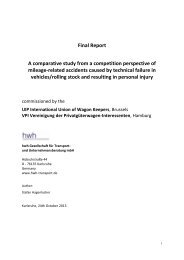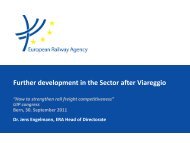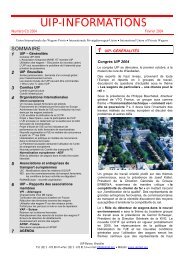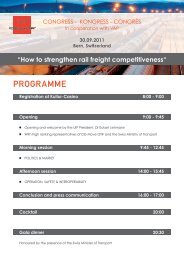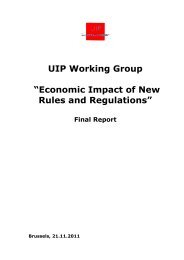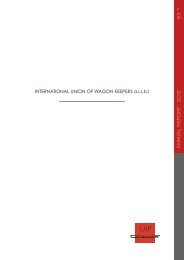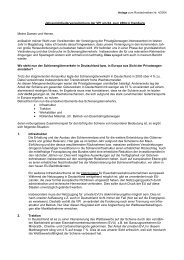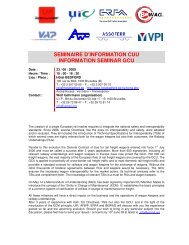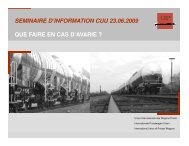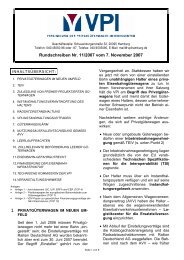Revision of Regulation 352/2009 on a CSM on risk assessment - UIP
Revision of Regulation 352/2009 on a CSM on risk assessment - UIP
Revision of Regulation 352/2009 on a CSM on risk assessment - UIP
- No tags were found...
Create successful ePaper yourself
Turn your PDF publications into a flip-book with our unique Google optimized e-Paper software.
Risk Management and Risk Assessment"Hazard" and "Risk" C<strong>on</strong>cepts Discovery <str<strong>on</strong>g>of</str<strong>on</strong>g> "theory <str<strong>on</strong>g>of</str<strong>on</strong>g> probability" during XVIIcentury, and later <strong>on</strong> its mathematical refining, haveactually laid down the mathematical instruments forthe decisi<strong>on</strong> making process During XVIII century, shipping insurance companiesfirst use those mathematics and probabilistic toolsfor assessing <strong>risk</strong>s and taking decisi<strong>on</strong>s Risk Management and Risk Assessment, as usednowadays, originate from 1960' Motivated by financial benefits, insurancecompanies first introduce "c<strong>on</strong>cept <str<strong>on</strong>g>of</str<strong>on</strong>g> <strong>risk</strong>" in their"process <str<strong>on</strong>g>of</str<strong>on</strong>g> taking decisi<strong>on</strong>s"<str<strong>on</strong>g>Revisi<strong>on</strong></str<strong>on</strong>g> <str<strong>on</strong>g>of</str<strong>on</strong>g> <strong>CSM</strong> for <strong>risk</strong> <strong>assessment</strong><strong>UIP</strong> Workshop in Köln, 27 th March 2013Slide N 4
Domains <str<strong>on</strong>g>of</str<strong>on</strong>g> applicati<strong>on</strong> <str<strong>on</strong>g>of</str<strong>on</strong>g>Risk Management and Risk Assessment ToolsC<strong>on</strong>sidered as a necessary modern and proactive instruments forc<strong>on</strong>trolling safety and taking decisi<strong>on</strong>s Finance, banking,capital investment Telecommunicati<strong>on</strong>s Public PolicyResearch Energy Medicine Petrochemicalindustry Nuclear Power Aviati<strong>on</strong> Railways<str<strong>on</strong>g>Revisi<strong>on</strong></str<strong>on</strong>g> <str<strong>on</strong>g>of</str<strong>on</strong>g> <strong>CSM</strong> for <strong>risk</strong> <strong>assessment</strong><strong>UIP</strong> Workshop in Köln, 27 th March 2013Slide N 5
Preventi<strong>on</strong> <str<strong>on</strong>g>of</str<strong>on</strong>g> accidents in the past &Modern Risk Management For l<strong>on</strong>g, in many domains, gradualimprovement <str<strong>on</strong>g>of</str<strong>on</strong>g> safety resulted from costlyexperiences and less<strong>on</strong>s learned from accidents Preventi<strong>on</strong> <str<strong>on</strong>g>of</str<strong>on</strong>g> similar events was regulatedreactively by state authorities andestablishment <str<strong>on</strong>g>of</str<strong>on</strong>g> new laws, codes <str<strong>on</strong>g>of</str<strong>on</strong>g> practice,rules or standards Development <str<strong>on</strong>g>of</str<strong>on</strong>g> modern and scientific methodsfor "Risk Assessment" and "Risk Management"enabled to substitute those reactive ways <str<strong>on</strong>g>of</str<strong>on</strong>g>c<strong>on</strong>trolling safety by a proactive and systematicapproach to manage safety<str<strong>on</strong>g>Revisi<strong>on</strong></str<strong>on</strong>g> <str<strong>on</strong>g>of</str<strong>on</strong>g> <strong>CSM</strong> for <strong>risk</strong> <strong>assessment</strong><strong>UIP</strong> Workshop in Köln, 27 th March 2013Slide N 6
Principles <str<strong>on</strong>g>of</str<strong>on</strong>g> modern proactive way for Risk ManagementRather than reacting to events from past, proactive safety management,based <strong>on</strong> <strong>risk</strong>s, ensures before any problem appears that : A proactive and systematic <strong>assessment</strong> <str<strong>on</strong>g>of</str<strong>on</strong>g>all reas<strong>on</strong>ably foreseeable problems(hazards) is performed Their causes and c<strong>on</strong>sequences (<strong>risk</strong>s) areanalysed Acceptable <strong>risk</strong> c<strong>on</strong>trol measuresare defined and implemented:Preventing the hazard (cause)Mitigating the severity <str<strong>on</strong>g>of</str<strong>on</strong>g> thec<strong>on</strong>sequences<str<strong>on</strong>g>Revisi<strong>on</strong></str<strong>on</strong>g> <str<strong>on</strong>g>of</str<strong>on</strong>g> <strong>CSM</strong> for <strong>risk</strong> <strong>assessment</strong><strong>UIP</strong> Workshop in Köln, 27 th March 2013Slide N 7
<str<strong>on</strong>g>Revisi<strong>on</strong></str<strong>on</strong>g> <str<strong>on</strong>g>of</str<strong>on</strong>g> <strong>CSM</strong> for <strong>risk</strong> <strong>assessment</strong><strong>UIP</strong> Workshop in Köln, 27 th March 2013Advantages <str<strong>on</strong>g>of</str<strong>on</strong>g> a proactivesafety management based <strong>on</strong> <strong>risk</strong> Documented process based <strong>on</strong> modern science and tools Process reducing subjectivity Enables <strong>risk</strong> categorisati<strong>on</strong> and setting up <str<strong>on</strong>g>of</str<strong>on</strong>g> priorities forc<strong>on</strong>trol <str<strong>on</strong>g>of</str<strong>on</strong>g> most important <strong>risk</strong>s Systematic definiti<strong>on</strong> <str<strong>on</strong>g>of</str<strong>on</strong>g> appropriate <strong>risk</strong> c<strong>on</strong>trolmeasures Facilitates managers to take c<strong>on</strong>sciously decisi<strong>on</strong>s(resp<strong>on</strong>sibility) C<strong>on</strong>sistent and traceable process Improves transparency within organisati<strong>on</strong>, to (external)independent assessors, as well as to regulatory bodies Builds mutual trust within company as well as am<strong>on</strong>gbusiness partnersSlide N 8
Risk Management is the name givento a logical and systematic method<str<strong>on</strong>g>of</str<strong>on</strong>g> identifying the hazards andanalysing, treating and m<strong>on</strong>itoringthe associated <strong>risk</strong>s involved in anyactivity or process <str<strong>on</strong>g>of</str<strong>on</strong>g> a companyWhat is "Risk Management"? The Risk Management methodologyshall be an integral part <str<strong>on</strong>g>of</str<strong>on</strong>g> thecompany business planning thathelps the managers to make thebest use <str<strong>on</strong>g>of</str<strong>on</strong>g> their available resources<str<strong>on</strong>g>Revisi<strong>on</strong></str<strong>on</strong>g> <str<strong>on</strong>g>of</str<strong>on</strong>g> <strong>CSM</strong> for <strong>risk</strong> <strong>assessment</strong><strong>UIP</strong> Workshop in Köln, 27 th March 2013Slide N 9
A general overview <strong>on</strong> Risk Management - ISO 31000Regardless <str<strong>on</strong>g>of</str<strong>on</strong>g> type <str<strong>on</strong>g>of</str<strong>on</strong>g> business, activity orfuncti<strong>on</strong> <str<strong>on</strong>g>of</str<strong>on</strong>g> company, Risk Management is 7step based processDefining c<strong>on</strong>text (System Definiti<strong>on</strong>)Risk Assessment Hazard/Risk Identificati<strong>on</strong> Risk Analysis Risk Evaluati<strong>on</strong>Risk C<strong>on</strong>trolRisk M<strong>on</strong>itoring and ReviewCommunicati<strong>on</strong> with and c<strong>on</strong>sult staff <strong>on</strong>company and their activity <strong>risk</strong>sBasic Process Steps‘Risk’ is dynamic and subject to c<strong>on</strong>stant change,so Risk Management process includes c<strong>on</strong>tinuousSystem Definiti<strong>on</strong>Hazard/RiskIdentificati<strong>on</strong>Risk AnalysisRisk Evaluati<strong>on</strong>Risk C<strong>on</strong>trolRisk M<strong>on</strong>itoring andReviewCommunicate andC<strong>on</strong>sult <strong>on</strong> <strong>risk</strong>sRisk AssessmentPart <str<strong>on</strong>g>of</str<strong>on</strong>g> SMS<str<strong>on</strong>g>Revisi<strong>on</strong></str<strong>on</strong>g> <str<strong>on</strong>g>of</str<strong>on</strong>g> <strong>CSM</strong> for <strong>risk</strong> <strong>assessment</strong><strong>UIP</strong> Workshop in Köln, 27 th March 2013Slide N 10
Risk Management in ISO/IEC Guide 73 and ISO 14 971stepName asdefined byinternati<strong>on</strong>alstandardsIdentify andcharacterisethe hazardHazardIdentificati<strong>on</strong>Risk AnalysisEstimate themagnitude <str<strong>on</strong>g>of</str<strong>on</strong>g>the <strong>risk</strong>RiskEstimati<strong>on</strong>Risk AssessmentDecide if that <strong>risk</strong>is acceptable (ortolerable)Risk Evaluati<strong>on</strong>Risk ManagementC<strong>on</strong>trolthe <strong>risk</strong>RiskC<strong>on</strong>trolRiskC<strong>on</strong>trolRiskC<strong>on</strong>trolM<strong>on</strong>itor the<strong>risk</strong>RiskM<strong>on</strong>itoringRiskReportingRisk AuditCovered by <str<strong>on</strong>g>Regulati<strong>on</strong></str<strong>on</strong>g> <str<strong>on</strong>g>352</str<strong>on</strong>g>/<str<strong>on</strong>g>2009</str<strong>on</strong>g>(<strong>CSM</strong> for <strong>risk</strong> <strong>assessment</strong>)<strong>CSM</strong> form<strong>on</strong>itoringCovered by RU/IM Safety Management System (SMS)<str<strong>on</strong>g>Revisi<strong>on</strong></str<strong>on</strong>g> <str<strong>on</strong>g>of</str<strong>on</strong>g> <strong>CSM</strong> for <strong>risk</strong> <strong>assessment</strong><strong>UIP</strong> Workshop in Köln, 27 th March 2013Slide N 11
Link <str<strong>on</strong>g>of</str<strong>on</strong>g> Risk Assessment & Risk Managementwith RU/IM SMS and ECM System <str<strong>on</strong>g>of</str<strong>on</strong>g> Maintenance A documented and structuredframework for safe management<str<strong>on</strong>g>of</str<strong>on</strong>g> all company activities Ensures appropriate processes,procedures and rules exist forc<strong>on</strong>trolling all company <strong>risk</strong>s Enables identificati<strong>on</strong> <str<strong>on</strong>g>of</str<strong>on</strong>g> hazardsand c<strong>on</strong>tinuous management <str<strong>on</strong>g>of</str<strong>on</strong>g><strong>risk</strong>s related to the companyactivities, with the aim <str<strong>on</strong>g>of</str<strong>on</strong>g>preventing accidents Uses scientific "<strong>risk</strong> management"tools to support companymanagers in taking c<strong>on</strong>sciouslydecisi<strong>on</strong>s for their business<str<strong>on</strong>g>Revisi<strong>on</strong></str<strong>on</strong>g> <str<strong>on</strong>g>of</str<strong>on</strong>g> <strong>CSM</strong> for <strong>risk</strong> <strong>assessment</strong><strong>UIP</strong> Workshop in Köln, 27 th March 2013Proce-duresRulesRiskmanagementProcessesSlide N 12
What is a RISK?What is a HAZARD?It is a source or situati<strong>on</strong> or act with apotential for harm in terms <str<strong>on</strong>g>of</str<strong>on</strong>g> humaninjury or damage to envir<strong>on</strong>ment or both(e.g. Toxic or flammable substances,electric energy, working at heights etc.) Hazard is something that has apotential to cause harm or injuryCombinati<strong>on</strong> <str<strong>on</strong>g>of</str<strong>on</strong>g> the likelihood <str<strong>on</strong>g>of</str<strong>on</strong>g> an occurrence <str<strong>on</strong>g>of</str<strong>on</strong>g>a hazardous event and the severity <str<strong>on</strong>g>of</str<strong>on</strong>g> injury,damage to envir<strong>on</strong>ment or damage to propertythat may be caused by the event Risk is the likelihood <str<strong>on</strong>g>of</str<strong>on</strong>g> harm resultingfrom a hazardHazard - Risk?<str<strong>on</strong>g>Revisi<strong>on</strong></str<strong>on</strong>g> <str<strong>on</strong>g>of</str<strong>on</strong>g> <strong>CSM</strong> for <strong>risk</strong> <strong>assessment</strong><strong>UIP</strong> Workshop in Köln, 27 th March 2013Slide N 13
Relati<strong>on</strong> between Hazard – Risk Definiti<strong>on</strong>sRisk = [Severity <str<strong>on</strong>g>of</str<strong>on</strong>g> Hazard effect] x [Probability(likelihood <str<strong>on</strong>g>of</str<strong>on</strong>g> occurrence) <str<strong>on</strong>g>of</str<strong>on</strong>g> Hazard]Definiti<strong>on</strong>s in <str<strong>on</strong>g>Regulati<strong>on</strong></str<strong>on</strong>g> <str<strong>on</strong>g>352</str<strong>on</strong>g>/<str<strong>on</strong>g>2009</str<strong>on</strong>g>Art. 3(13): ‘hazard’ means a c<strong>on</strong>diti<strong>on</strong> thatcould lead to an accident;Art. 3(1): ‘<strong>risk</strong>’ means the frequency <str<strong>on</strong>g>of</str<strong>on</strong>g> occurrence <str<strong>on</strong>g>of</str<strong>on</strong>g> accidentsand incidents resulting in harm (caused by a hazard)and the degree <str<strong>on</strong>g>of</str<strong>on</strong>g> severity <str<strong>on</strong>g>of</str<strong>on</strong>g> that harm;What is then Risk Assessment?A careful examinati<strong>on</strong> <str<strong>on</strong>g>of</str<strong>on</strong>g> what could cause harm to people, damageto envir<strong>on</strong>ment or to property, so that you can weigh up whetheryou have taken enough precauti<strong>on</strong>s or you should do more.Aim to make sure that no <strong>on</strong>e gets hurt or nothing is damaged<str<strong>on</strong>g>Revisi<strong>on</strong></str<strong>on</strong>g> <str<strong>on</strong>g>of</str<strong>on</strong>g> <strong>CSM</strong> for <strong>risk</strong> <strong>assessment</strong><strong>UIP</strong> Workshop in Köln, 27 th March 2013Slide N 14
Risk ParametersAs shown, <strong>risk</strong> is typically described in two dimensi<strong>on</strong>sHow <str<strong>on</strong>g>of</str<strong>on</strong>g>ten willan event occur?E.g. <strong>on</strong>ce per year,<strong>on</strong>ce every 10years, every day…FrequencyRisk= Frequency x SeverityIncreasingRiskSeverity <str<strong>on</strong>g>of</str<strong>on</strong>g> C<strong>on</strong>sequence<str<strong>on</strong>g>Revisi<strong>on</strong></str<strong>on</strong>g> <str<strong>on</strong>g>of</str<strong>on</strong>g> <strong>CSM</strong> for <strong>risk</strong> <strong>assessment</strong><strong>UIP</strong> Workshop in Köln, 27 th March 2013If the event does occur what couldbe the c<strong>on</strong>sequences?E.g. <strong>on</strong>e pers<strong>on</strong> injured, €10000damage, multiple fatalitiesSlide N 15
Other "key c<strong>on</strong>cepts" to know when talking about RiskIn order to understand ‘<strong>risk</strong>’, it is important to know following "key c<strong>on</strong>cepts"TerminologyAccidentIncidentHazardFrequencyProbabilitySeverityRisk (level<str<strong>on</strong>g>of</str<strong>on</strong>g>...)Explanati<strong>on</strong>s (not definiti<strong>on</strong>s from EU legislati<strong>on</strong>)Event (or sequence <str<strong>on</strong>g>of</str<strong>on</strong>g> events) that causes harmEvent that could cause harm (but may not)A c<strong>on</strong>diti<strong>on</strong> that could lead to an accident or an incidentNumber <str<strong>on</strong>g>of</str<strong>on</strong>g> times the hazard occurs in a specified period <str<strong>on</strong>g>of</str<strong>on</strong>g>timeLikelihood <str<strong>on</strong>g>of</str<strong>on</strong>g> an event occurring (usually per demand)The magnitude <str<strong>on</strong>g>of</str<strong>on</strong>g> harm from a hazardThe combinati<strong>on</strong> <str<strong>on</strong>g>of</str<strong>on</strong>g> frequency and severity <str<strong>on</strong>g>of</str<strong>on</strong>g> a specifiedhazard causing defined harm<str<strong>on</strong>g>Revisi<strong>on</strong></str<strong>on</strong>g> <str<strong>on</strong>g>of</str<strong>on</strong>g> <strong>CSM</strong> for <strong>risk</strong> <strong>assessment</strong><strong>UIP</strong> Workshop in Köln, 27 th March 2013Slide N 16
Other "key c<strong>on</strong>cepts" to know when talking about RiskFrequency <str<strong>on</strong>g>of</str<strong>on</strong>g> the associated hazardFrequency <strong>assessment</strong>Frequency can be expressed in a number <str<strong>on</strong>g>of</str<strong>on</strong>g> ways…….A train has derailed <strong>on</strong>e time in 20 years The frequency <str<strong>on</strong>g>of</str<strong>on</strong>g> derailment is 1 in every 20 years The average number <str<strong>on</strong>g>of</str<strong>on</strong>g> years between each derailment is 20years The frequency <str<strong>on</strong>g>of</str<strong>on</strong>g> derailment is 0.05 per year The frequency <str<strong>on</strong>g>of</str<strong>on</strong>g> derailment is 0.05/year The frequency <str<strong>on</strong>g>of</str<strong>on</strong>g> derailment is 5x10 -2 /year The frequency <str<strong>on</strong>g>of</str<strong>on</strong>g> derailment is 5E-02/year<str<strong>on</strong>g>Revisi<strong>on</strong></str<strong>on</strong>g> <str<strong>on</strong>g>of</str<strong>on</strong>g> <strong>CSM</strong> for <strong>risk</strong> <strong>assessment</strong><strong>UIP</strong> Workshop in Köln, 27 th March 2013Slide N 17
Risk: definiti<strong>on</strong>s and parametersSeverity <str<strong>on</strong>g>of</str<strong>on</strong>g> the associated hazardSeverity <strong>assessment</strong>Severity can be expressed in a number <str<strong>on</strong>g>of</str<strong>on</strong>g> ways…….1 serious injury, damage estimated at EUR 6.5 milli<strong>on</strong> The cost <str<strong>on</strong>g>of</str<strong>on</strong>g> damages; Fatalities; Injuries; Hours, minutes <str<strong>on</strong>g>of</str<strong>on</strong>g> service disrupti<strong>on</strong>; Envir<strong>on</strong>mental impact; Etc.<str<strong>on</strong>g>Revisi<strong>on</strong></str<strong>on</strong>g> <str<strong>on</strong>g>of</str<strong>on</strong>g> <strong>CSM</strong> for <strong>risk</strong> <strong>assessment</strong><strong>UIP</strong> Workshop in Köln, 27 th March 2013Slide N 18
Basic principles for assessing the <strong>risk</strong>Independently <strong>on</strong> whether complex or simple, Risk Assessmentfollows a comm<strong>on</strong> 4 step processYou 1 st identifyhazards… for each hazardyou estimate <strong>risk</strong> byestimatingfrequency andseverity… you thenevaluateacceptability <str<strong>on</strong>g>of</str<strong>on</strong>g> <strong>risk</strong>and prioritise …… If necessary youthen take acti<strong>on</strong> tomitigate/c<strong>on</strong>trol <strong>risk</strong>IdentifyHazardsEstimateFrequencyEstimateSeverityEstimateRisksReduceRisks whererequired1 2 3 4<str<strong>on</strong>g>Revisi<strong>on</strong></str<strong>on</strong>g> <str<strong>on</strong>g>of</str<strong>on</strong>g> <strong>CSM</strong> for <strong>risk</strong> <strong>assessment</strong><strong>UIP</strong> Workshop in Köln, 27 th March 2013Slide N 19
Most important c<strong>on</strong>cepts to rememberabout hazards & <strong>risk</strong>sWhat can go wr<strong>on</strong>g?HazardFrequencyHow likely is itto happen?SeverityWhat are the impactsor c<strong>on</strong>sequences?What is thelevel <str<strong>on</strong>g>of</str<strong>on</strong>g> <strong>risk</strong>?Managethe <strong>risk</strong>Risk = Hazard Frequencyx Hazard SeverityDo not forget that <strong>risk</strong> management includes c<strong>on</strong>trol but alsom<strong>on</strong>itoring <str<strong>on</strong>g>of</str<strong>on</strong>g> <strong>risk</strong>s, as well as communicating these <strong>risk</strong>s<str<strong>on</strong>g>Revisi<strong>on</strong></str<strong>on</strong>g> <str<strong>on</strong>g>of</str<strong>on</strong>g> <strong>CSM</strong> for <strong>risk</strong> <strong>assessment</strong><strong>UIP</strong> Workshop in Köln, 27 th March 2013Slide N 20
Why giving importance toRisk Management and Risk Assessment? (1/2) All domains <str<strong>on</strong>g>of</str<strong>on</strong>g> industry previously presented andsocial life c<strong>on</strong>sider "<strong>risk</strong>" as "source <str<strong>on</strong>g>of</str<strong>on</strong>g> danger"and possibility to face damage or accident fortheir company Risk is understood as potential for damage linkedto company activities that can result from currentcompany organisati<strong>on</strong>, current processes andmode <str<strong>on</strong>g>of</str<strong>on</strong>g> operati<strong>on</strong> <str<strong>on</strong>g>of</str<strong>on</strong>g> the company, technicalsystems or from any future events Risk Management is a formal tool to identify andprevent the cause <str<strong>on</strong>g>of</str<strong>on</strong>g> damage or accident to occuror to reduce the c<strong>on</strong>sequences if the occurrencecannot be avoided<str<strong>on</strong>g>Revisi<strong>on</strong></str<strong>on</strong>g> <str<strong>on</strong>g>of</str<strong>on</strong>g> <strong>CSM</strong> for <strong>risk</strong> <strong>assessment</strong><strong>UIP</strong> Workshop in Köln, 27 th March 2013Slide N 21
WARNINGWhy giving importance toRisk Management and Risk Assessment? (2/2) Risk <strong>assessment</strong> is a means to an end, not an end in itself.The aim is to keep people safe, not have good paperwork The <strong>risk</strong> analysis process depends <strong>on</strong> the experience, knowledge,imaginati<strong>on</strong>, creativity and integrity <str<strong>on</strong>g>of</str<strong>on</strong>g> the individuals doing theanalysis. The <strong>on</strong>ly applicati<strong>on</strong> <str<strong>on</strong>g>of</str<strong>on</strong>g> these techniques withoutappropriately talented/competent staff does not ensure a proper andthorough <strong>risk</strong> analysis result. The most important step in any <strong>risk</strong> <strong>assessment</strong> is thathazards can <strong>on</strong>ly be c<strong>on</strong>trolled if they are identified You must not say ‘never.’ Risk <strong>assessment</strong> predicts probabilities.Although a particular event may be infinitesimally improbable, theprobability is always greater than zero.<str<strong>on</strong>g>Revisi<strong>on</strong></str<strong>on</strong>g> <str<strong>on</strong>g>of</str<strong>on</strong>g> <strong>CSM</strong> for <strong>risk</strong> <strong>assessment</strong><strong>UIP</strong> Workshop in Köln, 27 th March 2013Slide N 22
Remember theseRisk AssessmentWhat can happen?How likely is it to happen?What are the c<strong>on</strong>sequencesif it happens?Risk ManagementWhat can be d<strong>on</strong>e?What are the benefits, costs and<strong>risk</strong>s <str<strong>on</strong>g>of</str<strong>on</strong>g> each opti<strong>on</strong>?What are the impacts <str<strong>on</strong>g>of</str<strong>on</strong>g> eachopti<strong>on</strong> <strong>on</strong> future opti<strong>on</strong>s?Risk <strong>assessment</strong> is a means to an end, not an end in itself -the aim is to keep people safe, not have good paperwork<str<strong>on</strong>g>Revisi<strong>on</strong></str<strong>on</strong>g> <str<strong>on</strong>g>of</str<strong>on</strong>g> <strong>CSM</strong> for <strong>risk</strong> <strong>assessment</strong><strong>UIP</strong> Workshop in Köln, 27 th March 2013Slide N 23
Overview <str<strong>on</strong>g>of</str<strong>on</strong>g> the existing <str<strong>on</strong>g>Regulati<strong>on</strong></str<strong>on</strong>g> (EU)N°<str<strong>on</strong>g>352</str<strong>on</strong>g>/<str<strong>on</strong>g>2009</str<strong>on</strong>g> <strong>on</strong> <strong>CSM</strong> <strong>on</strong> Risk Assessment<str<strong>on</strong>g>Revisi<strong>on</strong></str<strong>on</strong>g> <str<strong>on</strong>g>of</str<strong>on</strong>g> <strong>CSM</strong> for <strong>risk</strong> <strong>assessment</strong><strong>UIP</strong> Workshop in Köln, 27 th March 2013Slide N 24
<str<strong>on</strong>g>Regulati<strong>on</strong></str<strong>on</strong>g> (EU) N°<str<strong>on</strong>g>352</str<strong>on</strong>g>/<str<strong>on</strong>g>2009</str<strong>on</strong>g> <strong>on</strong> <strong>CSM</strong> for Risk AssessmentRequirements in the safety directive 2004/49/ECArticle 6(3)(a) <str<strong>on</strong>g>of</str<strong>on</strong>g> the safety directive 2004/49/EC requires thatthe European Railway Agency develops a comm<strong>on</strong> safetymethod that “... shall describe how the safety level… andcompliance with… safety requirements, are assessed byelaborating and defining <strong>risk</strong> evaluati<strong>on</strong> and <strong>assessment</strong>methods“ Development <str<strong>on</strong>g>of</str<strong>on</strong>g> the Agency recommendati<strong>on</strong> <strong>on</strong> a Comm<strong>on</strong>Safety Method <str<strong>on</strong>g>of</str<strong>on</strong>g> <strong>risk</strong> <strong>assessment</strong>Adopti<strong>on</strong> by the RISC in <str<strong>on</strong>g>2009</str<strong>on</strong>g>Commissi<strong>on</strong> <str<strong>on</strong>g>Regulati<strong>on</strong></str<strong>on</strong>g> (EC) N°<str<strong>on</strong>g>352</str<strong>on</strong>g>/<str<strong>on</strong>g>2009</str<strong>on</strong>g> <strong>on</strong> Comm<strong>on</strong> SafetyMethods (<strong>CSM</strong>) <strong>on</strong> Risk Evaluati<strong>on</strong> and Risk Assessment<str<strong>on</strong>g>Revisi<strong>on</strong></str<strong>on</strong>g> <str<strong>on</strong>g>of</str<strong>on</strong>g> <strong>CSM</strong> for <strong>risk</strong> <strong>assessment</strong><strong>UIP</strong> Workshop in Köln, 27 th March 2013Slide N 25
Auth. for placing in service SMS – Syst <str<strong>on</strong>g>of</str<strong>on</strong>g> Maint.RUIMECMC<strong>on</strong>tractingEntityApplicantfor an APIS(a)Overview <str<strong>on</strong>g>of</str<strong>on</strong>g> existing <str<strong>on</strong>g>Regulati<strong>on</strong></str<strong>on</strong>g> N <str<strong>on</strong>g>352</str<strong>on</strong>g>/<str<strong>on</strong>g>2009</str<strong>on</strong>g>WHO shall apply the <strong>CSM</strong>? The proposer Art. 3(11)a railway undertaking or an infrastructure manager whichimplements <strong>risk</strong> c<strong>on</strong>trol measures vs. Art. 4 <str<strong>on</strong>g>of</str<strong>on</strong>g> Directive2004/49;(b) an entity in charge <str<strong>on</strong>g>of</str<strong>on</strong>g> maintenance which implementsmeasures in accordance with Article 14a(3) <str<strong>on</strong>g>of</str<strong>on</strong>g> Directive2004/49;Directive 2004/49 - Through RU/IM SMS & ECM Maintenance System(c)(d)a c<strong>on</strong>tracting entity or a manufacturer which invites aNOBO to apply the “EC” verificati<strong>on</strong> procedure inaccordance with Article 18(1) <str<strong>on</strong>g>of</str<strong>on</strong>g> Directive 2008/57 or adesignated body according to Article 17(3) <str<strong>on</strong>g>of</str<strong>on</strong>g> that Directive;an applicant for an authorisati<strong>on</strong> for the placing in service<str<strong>on</strong>g>of</str<strong>on</strong>g> structural sub-systems [Manufacturer, RU or Keeper];Directive 2008/57 - Authorisati<strong>on</strong> for placing in service (APIS)<str<strong>on</strong>g>Revisi<strong>on</strong></str<strong>on</strong>g> <str<strong>on</strong>g>of</str<strong>on</strong>g> <strong>CSM</strong> for <strong>risk</strong> <strong>assessment</strong><strong>UIP</strong> Workshop in Köln, 27 th March 2013Slide N 26
Overview <str<strong>on</strong>g>of</str<strong>on</strong>g> existing <str<strong>on</strong>g>Regulati<strong>on</strong></str<strong>on</strong>g> N <str<strong>on</strong>g>352</str<strong>on</strong>g>/<str<strong>on</strong>g>2009</str<strong>on</strong>g>WHEN shall the <strong>CSM</strong> be applied?WHEN? when making a significant change to railway system whichcan impose new <strong>risk</strong>s <strong>on</strong> infrastructure or <strong>on</strong> operati<strong>on</strong>s:applied since 2010 for technical systems,applied since 2012 for operati<strong>on</strong>al or organisati<strong>on</strong>al<str<strong>on</strong>g>Revisi<strong>on</strong></str<strong>on</strong>g> <str<strong>on</strong>g>of</str<strong>on</strong>g> <strong>CSM</strong> for <strong>risk</strong> <strong>assessment</strong><strong>UIP</strong> Workshop in Köln, 27 th March 2013Slide N 27
Reas<strong>on</strong>able use <str<strong>on</strong>g>of</str<strong>on</strong>g> <strong>CSM</strong> for <strong>risk</strong> <strong>assessment</strong>Significant – N<strong>on</strong> Significant in <str<strong>on</strong>g>Regulati<strong>on</strong></str<strong>on</strong>g> <str<strong>on</strong>g>352</str<strong>on</strong>g>/<str<strong>on</strong>g>2009</str<strong>on</strong>g>When making a change ask yourself whether change is significant [Article 4]1) Not significant:a) because not safety related: document for transparencyreas<strong>on</strong>s;b) safety related but not significant because either <strong>risk</strong> is alreadyunder c<strong>on</strong>trol with existing provisi<strong>on</strong>s or it can be c<strong>on</strong>trolledby well known measures SMS requires to dem<strong>on</strong>strate that all <strong>risk</strong>s related to thecompany activities are managed, including thus management<str<strong>on</strong>g>of</str<strong>on</strong>g> changes. So, the proposer has to apply hisprocedures/process for <strong>risk</strong> management described in SMS2) Significant apply <str<strong>on</strong>g>Regulati<strong>on</strong></str<strong>on</strong>g> <str<strong>on</strong>g>352</str<strong>on</strong>g>/<str<strong>on</strong>g>2009</str<strong>on</strong>g><str<strong>on</strong>g>Revisi<strong>on</strong></str<strong>on</strong>g> <str<strong>on</strong>g>of</str<strong>on</strong>g> <strong>CSM</strong> for <strong>risk</strong> <strong>assessment</strong><strong>UIP</strong> Workshop in Köln, 27 th March 2013Slide N 28
Reas<strong>on</strong>able use <str<strong>on</strong>g>of</str<strong>on</strong>g> <strong>CSM</strong> for <strong>risk</strong> <strong>assessment</strong>Is change significant or not Significant (Art. 4)?NOIs the changesafety related?YESApplicati<strong>on</strong> <str<strong>on</strong>g>of</str<strong>on</strong>g> all criteria in Article 4(2) <str<strong>on</strong>g>of</str<strong>on</strong>g><str<strong>on</strong>g>Regulati<strong>on</strong></str<strong>on</strong>g> <str<strong>on</strong>g>352</str<strong>on</strong>g>/<str<strong>on</strong>g>2009</str<strong>on</strong>g>Applicati<strong>on</strong> <str<strong>on</strong>g>of</str<strong>on</strong>g> <strong>CSM</strong>not neededYESIs associated <strong>risk</strong>already c<strong>on</strong>trolled and thusacceptable?NOCan <strong>risk</strong> bemanaged by well knownmeasures?YESChange is NOT SIGNIFICANTNOChange isSIGNIFICANTDocumentdecisi<strong>on</strong>(transparency)<str<strong>on</strong>g>Revisi<strong>on</strong></str<strong>on</strong>g> <str<strong>on</strong>g>of</str<strong>on</strong>g> <strong>CSM</strong> for <strong>risk</strong> <strong>assessment</strong><strong>UIP</strong> Workshop in Köln, 27 th March 2013Applicati<strong>on</strong> <str<strong>on</strong>g>of</str<strong>on</strong>g> <str<strong>on</strong>g>Regulati<strong>on</strong></str<strong>on</strong>g> <str<strong>on</strong>g>352</str<strong>on</strong>g>/<str<strong>on</strong>g>2009</str<strong>on</strong>g> not mandatoryApply company procedures for Risk Assessment &Risk Management - Document decisi<strong>on</strong> &activities related to manner <strong>risk</strong> is c<strong>on</strong>trolledFull applicati<strong>on</strong> <str<strong>on</strong>g>of</str<strong>on</strong>g><strong>CSM</strong> for <strong>risk</strong><strong>assessment</strong> andprocess in Annex ISlide N 29
A comm<strong>on</strong> <strong>risk</strong> <strong>assessment</strong> process(a) Identificati<strong>on</strong> <str<strong>on</strong>g>of</str<strong>on</strong>g> hazards/<strong>risk</strong>s &associated safety measures(b) Risk analysis based <strong>on</strong> exiting <strong>risk</strong>acceptance principles(c) Risk evaluati<strong>on</strong> for checkingacceptance <str<strong>on</strong>g>of</str<strong>on</strong>g> <strong>risk</strong>(s)(d) Definiti<strong>on</strong> <str<strong>on</strong>g>of</str<strong>on</strong>g> safety requirementsfrom identified safety measuresOverview <str<strong>on</strong>g>of</str<strong>on</strong>g> existing <str<strong>on</strong>g>Regulati<strong>on</strong></str<strong>on</strong>g> N°<str<strong>on</strong>g>352</str<strong>on</strong>g>/<str<strong>on</strong>g>2009</str<strong>on</strong>g>Risk Management Process and Independent Assessment<strong>CSM</strong> for RA is an iterative process defining:Dem<strong>on</strong>strati<strong>on</strong> <str<strong>on</strong>g>of</str<strong>on</strong>g> systemcompliance with identified safetyrequirementsRequirements for mutual recogniti<strong>on</strong>:(a) Hazard Management(b) Independent Assessment(Assessment Body)<str<strong>on</strong>g>Revisi<strong>on</strong></str<strong>on</strong>g> <str<strong>on</strong>g>of</str<strong>on</strong>g> <strong>CSM</strong> for <strong>risk</strong> <strong>assessment</strong><strong>UIP</strong> Workshop in Köln, 27 th March 2013INDEPENDENT ASSESSMENTPreliminarySystemDefiniti<strong>on</strong>Codes <str<strong>on</strong>g>of</str<strong>on</strong>g>PracticeSignificantChange?SYSTEM DEFINITIONRISK ASSESSMENTRISK ANALYSISHAZARD IDENTIFICATIONAND CLASSIFICATIONSimilarReferenceSystemsRISK EVALUATION(vs. Risk Acceptance Criteria)Safety Requirements (i.e. safetymeasures to be implemented)Dem<strong>on</strong>strati<strong>on</strong> <str<strong>on</strong>g>of</str<strong>on</strong>g> Compliance withSafety RequirementsIterative Risk Management Process“triggered” by a Significant ChangeExplicitRiskEstimati<strong>on</strong>HAZARD MANAGEMENTSlide N 30
<str<strong>on</strong>g>Revisi<strong>on</strong></str<strong>on</strong>g> <str<strong>on</strong>g>of</str<strong>on</strong>g> <str<strong>on</strong>g>Regulati<strong>on</strong></str<strong>on</strong>g> (EU) N <str<strong>on</strong>g>352</str<strong>on</strong>g>/<str<strong>on</strong>g>2009</str<strong>on</strong>g>for the <strong>CSM</strong> <strong>on</strong> <strong>risk</strong> <strong>assessment</strong><str<strong>on</strong>g>Revisi<strong>on</strong></str<strong>on</strong>g> <str<strong>on</strong>g>of</str<strong>on</strong>g> <strong>CSM</strong> for <strong>risk</strong> <strong>assessment</strong><strong>UIP</strong> Workshop in Köln, 27 th March 2013Slide N 31
Why revising <str<strong>on</strong>g>Regulati<strong>on</strong></str<strong>on</strong>g> <str<strong>on</strong>g>352</str<strong>on</strong>g>/<str<strong>on</strong>g>2009</str<strong>on</strong>g>?Commissi<strong>on</strong> Mandate - Inputs for revisi<strong>on</strong>In <str<strong>on</strong>g>352</str<strong>on</strong>g>/<str<strong>on</strong>g>2009</str<strong>on</strong>g> further help needed:1. Independent Assessment Body2. Risk Acceptance Criteria (RAC)3. Understanding <str<strong>on</strong>g>of</str<strong>on</strong>g> <strong>CSM</strong>2007-<str<strong>on</strong>g>2009</str<strong>on</strong>g>-2011: development R&R <str<strong>on</strong>g>of</str<strong>on</strong>g>AB and other RAC + Disseminati<strong>on</strong> WSCommissi<strong>on</strong> mandate in 2010 forrevising by April 2012 <strong>CSM</strong> <strong>on</strong> RA vs.1. results <str<strong>on</strong>g>of</str<strong>on</strong>g> further dev nts in WG2. Art. 9(4) <str<strong>on</strong>g>of</str<strong>on</strong>g> Reg. <str<strong>on</strong>g>352</str<strong>on</strong>g>/<str<strong>on</strong>g>2009</str<strong>on</strong>g> report <strong>on</strong>experience with <strong>CSM</strong> [Dec. 2011]1Inputs for revisi<strong>on</strong> results <str<strong>on</strong>g>of</str<strong>on</strong>g>:1. TF <strong>on</strong> R&R <str<strong>on</strong>g>of</str<strong>on</strong>g> AB Regularly2. TF <strong>on</strong> RACs reported to WG3. Agency report to EC in 2011 <strong>on</strong>experience with <str<strong>on</strong>g>352</str<strong>on</strong>g>/<str<strong>on</strong>g>2009</str<strong>on</strong>g> based <strong>on</strong>disseminati<strong>on</strong> WS & first uses <str<strong>on</strong>g>of</str<strong>on</strong>g> <strong>CSM</strong><str<strong>on</strong>g>Revisi<strong>on</strong></str<strong>on</strong>g> <str<strong>on</strong>g>of</str<strong>on</strong>g> <strong>CSM</strong> for <strong>risk</strong> <strong>assessment</strong><strong>UIP</strong> Workshop in Köln, 27 th March 20132Slide N 32
<str<strong>on</strong>g>Revisi<strong>on</strong></str<strong>on</strong>g> <str<strong>on</strong>g>of</str<strong>on</strong>g> <str<strong>on</strong>g>Regulati<strong>on</strong></str<strong>on</strong>g> <str<strong>on</strong>g>352</str<strong>on</strong>g>/<str<strong>on</strong>g>2009</str<strong>on</strong>g>Main Changes initially plannedRisk Assessment and Risk Management process (i.e. Annex I) <str<strong>on</strong>g>of</str<strong>on</strong>g><str<strong>on</strong>g>Regulati<strong>on</strong></str<strong>on</strong>g> <str<strong>on</strong>g>352</str<strong>on</strong>g>/<str<strong>on</strong>g>2009</str<strong>on</strong>g> not changedMain changes related to new requirements for Assessment Bodies Article 6: requirements for Accreditati<strong>on</strong> and Recogniti<strong>on</strong> schemes Article 7 & Annex III: structure <str<strong>on</strong>g>of</str<strong>on</strong>g> safety <strong>assessment</strong> report <str<strong>on</strong>g>of</str<strong>on</strong>g> AB Annex II: review <str<strong>on</strong>g>of</str<strong>on</strong>g> existing criteria and setting up <str<strong>on</strong>g>of</str<strong>on</strong>g> additi<strong>on</strong>al criteriato be fulfilled by ABMain changes for RAC : mainly in §2.5 <str<strong>on</strong>g>of</str<strong>on</strong>g> Annex I - Introducti<strong>on</strong> <str<strong>on</strong>g>of</str<strong>on</strong>g>additi<strong>on</strong>al RAC categories for design targets <str<strong>on</strong>g>of</str<strong>on</strong>g> Technical SystemsSome changes requested at NSA Network meetingsSome minor changes facilitating reading <str<strong>on</strong>g>of</str<strong>on</strong>g> <strong>CSM</strong> and suggesti<strong>on</strong>scollected through disseminati<strong>on</strong> workshops in <str<strong>on</strong>g>2009</str<strong>on</strong>g> & 2010<str<strong>on</strong>g>Revisi<strong>on</strong></str<strong>on</strong>g> <str<strong>on</strong>g>of</str<strong>on</strong>g> <strong>CSM</strong> for <strong>risk</strong> <strong>assessment</strong><strong>UIP</strong> Workshop in Köln, 27 th March 2013Slide N 33
Final Status <str<strong>on</strong>g>of</str<strong>on</strong>g> <str<strong>on</strong>g>Revisi<strong>on</strong></str<strong>on</strong>g> <str<strong>on</strong>g>of</str<strong>on</strong>g> <str<strong>on</strong>g>Regulati<strong>on</strong></str<strong>on</strong>g> <str<strong>on</strong>g>352</str<strong>on</strong>g>/<str<strong>on</strong>g>2009</str<strong>on</strong>g>Reduced scopeA comm<strong>on</strong> view <strong>on</strong> harm<strong>on</strong>ised and agreed RAC could not be reached am<strong>on</strong>ga majority <str<strong>on</strong>g>of</str<strong>on</strong>g> representatives in WG. Several NSAs (AT, DE, ES, FR, IT)requested more time for analysing deeper RAC Validati<strong>on</strong> work performed byCER and RAC Impact Assessment resultsC<strong>on</strong>sequences: based <strong>on</strong> needs for clarifying the requirements for theAssessment Bodies in Reg. <str<strong>on</strong>g>352</str<strong>on</strong>g>/<str<strong>on</strong>g>2009</str<strong>on</strong>g>, the EC & Agency decided to:Cancel changes related to RACs and reduce the scope <str<strong>on</strong>g>of</str<strong>on</strong>g> the revisi<strong>on</strong> <str<strong>on</strong>g>of</str<strong>on</strong>g><str<strong>on</strong>g>Regulati<strong>on</strong></str<strong>on</strong>g> <str<strong>on</strong>g>352</str<strong>on</strong>g>/<str<strong>on</strong>g>2009</str<strong>on</strong>g>;Difficulties for harm<strong>on</strong>ising RACs documented in Accompanying Report;Give more time to railway sector organisati<strong>on</strong>s (CER, EIM, <strong>UIP</strong> & UNIFE) &NSAs for additi<strong>on</strong>al validati<strong>on</strong> and agreements for harm<strong>on</strong>ised RACs;Based <strong>on</strong> this additi<strong>on</strong>al RAC validati<strong>on</strong> work decide <strong>on</strong> how to makethem legally biding (e.g. a new revisi<strong>on</strong> <str<strong>on</strong>g>of</str<strong>on</strong>g> <strong>CSM</strong> for <strong>risk</strong> <strong>assessment</strong>);<str<strong>on</strong>g>Revisi<strong>on</strong></str<strong>on</strong>g> <str<strong>on</strong>g>of</str<strong>on</strong>g> <strong>CSM</strong> for <strong>risk</strong> <strong>assessment</strong><strong>UIP</strong> Workshop in Köln, 27 th March 2013Slide N 34
To enable mutual recogniti<strong>on</strong> <str<strong>on</strong>g>of</str<strong>on</strong>g> results from <strong>CSM</strong>, <str<strong>on</strong>g>Regulati<strong>on</strong></str<strong>on</strong>g> <str<strong>on</strong>g>352</str<strong>on</strong>g>/<str<strong>on</strong>g>2009</str<strong>on</strong>g>requires an independent <strong>assessment</strong>s <str<strong>on</strong>g>of</str<strong>on</strong>g> correct applicati<strong>on</strong> <str<strong>on</strong>g>of</str<strong>on</strong>g> <strong>CSM</strong> <str<strong>on</strong>g>Regulati<strong>on</strong></str<strong>on</strong>g> <str<strong>on</strong>g>352</str<strong>on</strong>g>/<str<strong>on</strong>g>2009</str<strong>on</strong>g> answered "WHO?" can be Assessment Body vs.general criteria c<strong>on</strong>tained in Annex II (mainly independence & competence) To establish sufficient trust <str<strong>on</strong>g>of</str<strong>on</strong>g> work performed by the Assessment Body,following questi<strong>on</strong>s <strong>on</strong> <str<strong>on</strong>g>Regulati<strong>on</strong></str<strong>on</strong>g> <str<strong>on</strong>g>352</str<strong>on</strong>g>/<str<strong>on</strong>g>2009</str<strong>on</strong>g> needed also an answer: WHEN shall independent <strong>assessment</strong> be d<strong>on</strong>e? WHAT shall be assessed?<str<strong>on</strong>g>Revisi<strong>on</strong></str<strong>on</strong>g> <str<strong>on</strong>g>of</str<strong>on</strong>g> <str<strong>on</strong>g>Regulati<strong>on</strong></str<strong>on</strong>g> <str<strong>on</strong>g>352</str<strong>on</strong>g>/<str<strong>on</strong>g>2009</str<strong>on</strong>g> for Risk AssessmentWhy to revise it whereas RAC not yet agreed? What is the interacti<strong>on</strong> with other <strong>assessment</strong>s (i.e. Safety certificati<strong>on</strong> &authorisati<strong>on</strong> process for placing in service structural sub-systems)? What are the additi<strong>on</strong>al requirements for the <strong>assessment</strong> body? HOW <strong>assessment</strong>s shall be performed ? WHICH scheme could ensure similar quality <str<strong>on</strong>g>of</str<strong>on</strong>g> the <strong>assessment</strong>s?<str<strong>on</strong>g>Revisi<strong>on</strong></str<strong>on</strong>g> <str<strong>on</strong>g>of</str<strong>on</strong>g> <strong>CSM</strong> for <strong>risk</strong> <strong>assessment</strong><strong>UIP</strong> Workshop in Köln, 27 th March 2013Slide N 35
Changes to <str<strong>on</strong>g>Regulati<strong>on</strong></str<strong>on</strong>g> <str<strong>on</strong>g>352</str<strong>on</strong>g>/<str<strong>on</strong>g>2009</str<strong>on</strong>g> forRoles & Resp<strong>on</strong>sibilities<str<strong>on</strong>g>of</str<strong>on</strong>g> Assessment Body<str<strong>on</strong>g>Revisi<strong>on</strong></str<strong>on</strong>g> <str<strong>on</strong>g>of</str<strong>on</strong>g> <strong>CSM</strong> for <strong>risk</strong> <strong>assessment</strong><strong>UIP</strong> Workshop in Köln, 27 th March 2013Slide N 36
<str<strong>on</strong>g>Revisi<strong>on</strong></str<strong>on</strong>g> <str<strong>on</strong>g>of</str<strong>on</strong>g> <str<strong>on</strong>g>Regulati<strong>on</strong></str<strong>on</strong>g> <str<strong>on</strong>g>352</str<strong>on</strong>g>/<str<strong>on</strong>g>2009</str<strong>on</strong>g> for Risk AssessmentAccreditati<strong>on</strong>/Recogniti<strong>on</strong> <str<strong>on</strong>g>of</str<strong>on</strong>g> Assessment Body Assessment Body shall be either (Article 7):(a)(b)(c)accredited by the nati<strong>on</strong>al accreditati<strong>on</strong> bodyusing the criteria defined in Annex II, or;recognised by the recogniti<strong>on</strong> bodyusing the criteria defined in Annex II, or;the nati<strong>on</strong>al safety authority designated by the MemberState as able to c<strong>on</strong>duct independent <strong>assessment</strong>Art. 9(2) When Member State recognises NSA as an <strong>assessment</strong>body, it is the resp<strong>on</strong>sibility <str<strong>on</strong>g>of</str<strong>on</strong>g> that Member State to ensurethat NSA fulfills requirements set out in Annex II.In this case, Assessment Body functi<strong>on</strong>s <str<strong>on</strong>g>of</str<strong>on</strong>g> NSA shall bedem<strong>on</strong>strably independent <str<strong>on</strong>g>of</str<strong>on</strong>g> the other functi<strong>on</strong>s <str<strong>on</strong>g>of</str<strong>on</strong>g> NSA.<str<strong>on</strong>g>Revisi<strong>on</strong></str<strong>on</strong>g> <str<strong>on</strong>g>of</str<strong>on</strong>g> <strong>CSM</strong> for <strong>risk</strong> <strong>assessment</strong><strong>UIP</strong> Workshop in Köln, 27 th March 2013Slide N 37
<str<strong>on</strong>g>Revisi<strong>on</strong></str<strong>on</strong>g> <str<strong>on</strong>g>of</str<strong>on</strong>g> <str<strong>on</strong>g>Regulati<strong>on</strong></str<strong>on</strong>g> <str<strong>on</strong>g>352</str<strong>on</strong>g>/<str<strong>on</strong>g>2009</str<strong>on</strong>g> for Risk AssessmentTypes <str<strong>on</strong>g>of</str<strong>on</strong>g> Recogniti<strong>on</strong> <str<strong>on</strong>g>of</str<strong>on</strong>g> Assessment Body (Art. 9)(a) recogniti<strong>on</strong> by Member State <str<strong>on</strong>g>of</str<strong>on</strong>g> an ECM, an organisati<strong>on</strong> or a part<str<strong>on</strong>g>of</str<strong>on</strong>g> it or an individual;(b) recogniti<strong>on</strong> by NSA <str<strong>on</strong>g>of</str<strong>on</strong>g> ability <str<strong>on</strong>g>of</str<strong>on</strong>g> an organisati<strong>on</strong> or a part <str<strong>on</strong>g>of</str<strong>on</strong>g> it oran individual to c<strong>on</strong>duct independent <strong>assessment</strong> through the<strong>assessment</strong> and supervisi<strong>on</strong> <str<strong>on</strong>g>of</str<strong>on</strong>g> SMS <str<strong>on</strong>g>of</str<strong>on</strong>g> an RU/IM;(c) when NSA is acting as certificati<strong>on</strong> body in c<strong>on</strong>formity with Article10 <str<strong>on</strong>g>of</str<strong>on</strong>g> <str<strong>on</strong>g>Regulati<strong>on</strong></str<strong>on</strong>g> (EU) No 445/2011, recogniti<strong>on</strong> by NSA <str<strong>on</strong>g>of</str<strong>on</strong>g> theability <str<strong>on</strong>g>of</str<strong>on</strong>g> an organisati<strong>on</strong> or a part <str<strong>on</strong>g>of</str<strong>on</strong>g> it or an individual to c<strong>on</strong>ductindependent <strong>assessment</strong> through <strong>assessment</strong> and surveillance <str<strong>on</strong>g>of</str<strong>on</strong>g>System <str<strong>on</strong>g>of</str<strong>on</strong>g> Maintenance <str<strong>on</strong>g>of</str<strong>on</strong>g> an ECM;(d) recogniti<strong>on</strong> by a recogniti<strong>on</strong> body designated by Member State <str<strong>on</strong>g>of</str<strong>on</strong>g>ability <str<strong>on</strong>g>of</str<strong>on</strong>g> an ECM, an organisati<strong>on</strong> or a part <str<strong>on</strong>g>of</str<strong>on</strong>g> it or an individual toc<strong>on</strong>duct independent <strong>assessment</strong>.<str<strong>on</strong>g>Revisi<strong>on</strong></str<strong>on</strong>g> <str<strong>on</strong>g>of</str<strong>on</strong>g> <strong>CSM</strong> for <strong>risk</strong> <strong>assessment</strong><strong>UIP</strong> Workshop in Köln, 27 th March 2013Slide N 38
<str<strong>on</strong>g>Revisi<strong>on</strong></str<strong>on</strong>g> <str<strong>on</strong>g>of</str<strong>on</strong>g> <str<strong>on</strong>g>Regulati<strong>on</strong></str<strong>on</strong>g> <str<strong>on</strong>g>352</str<strong>on</strong>g>/<str<strong>on</strong>g>2009</str<strong>on</strong>g> for Risk AssessmentChangesAnnex I <strong>on</strong> "<strong>risk</strong> <strong>assessment</strong> & <strong>risk</strong> management process" (includingflowchart) <str<strong>on</strong>g>of</str<strong>on</strong>g> <str<strong>on</strong>g>Regulati<strong>on</strong></str<strong>on</strong>g> <str<strong>on</strong>g>352</str<strong>on</strong>g>/<str<strong>on</strong>g>2009</str<strong>on</strong>g> were not changedChanges to ensure similar quality <str<strong>on</strong>g>of</str<strong>on</strong>g> independent <strong>assessment</strong> work: Accreditati<strong>on</strong> and Recogniti<strong>on</strong> schemes for Assessment Body Specificati<strong>on</strong> <strong>on</strong> how to arrive at judgement <str<strong>on</strong>g>of</str<strong>on</strong>g> suitability <str<strong>on</strong>g>of</str<strong>on</strong>g>applicati<strong>on</strong> <str<strong>on</strong>g>of</str<strong>on</strong>g> <strong>CSM</strong> and <str<strong>on</strong>g>of</str<strong>on</strong>g> appropriateness <str<strong>on</strong>g>of</str<strong>on</strong>g> its results Comm<strong>on</strong> structure for independent safety <strong>assessment</strong> report Review <str<strong>on</strong>g>of</str<strong>on</strong>g> existing criteria in Annex II to be fulfilled by AssessmentBody and completi<strong>on</strong> with additi<strong>on</strong>al criteriaCriteria: use <str<strong>on</strong>g>of</str<strong>on</strong>g> ISO/IEC 17020:2012 standard + specific requirements for<strong>CSM</strong> for <strong>risk</strong> <strong>assessment</strong> (e.g. competence in railways)<str<strong>on</strong>g>Revisi<strong>on</strong></str<strong>on</strong>g> <str<strong>on</strong>g>of</str<strong>on</strong>g> <strong>CSM</strong> for <strong>risk</strong> <strong>assessment</strong><strong>UIP</strong> Workshop in Köln, 27 th March 2013Slide N 39
<str<strong>on</strong>g>Revisi<strong>on</strong></str<strong>on</strong>g> <str<strong>on</strong>g>of</str<strong>on</strong>g> <str<strong>on</strong>g>Regulati<strong>on</strong></str<strong>on</strong>g> <str<strong>on</strong>g>352</str<strong>on</strong>g>/<str<strong>on</strong>g>2009</str<strong>on</strong>g> for Risk AssessmentChangesThe Member State are allowed to use accreditati<strong>on</strong> or recogniti<strong>on</strong> or anycombinati<strong>on</strong> <str<strong>on</strong>g>of</str<strong>on</strong>g> these two opti<strong>on</strong>sThere may be several <strong>assessment</strong> bodies, variously accredited orrecognised, or no <strong>assessment</strong> bodies at all within a Member StateNote: additi<strong>on</strong>al Risk Acceptance Criteria (RAC) for Technical Systems:A comm<strong>on</strong> view <strong>on</strong> additi<strong>on</strong>al harm<strong>on</strong>ised RAC could not be reached→ RAC not included in current revisi<strong>on</strong> workAgreement to leave more time for a deeper analysis, validati<strong>on</strong> andec<strong>on</strong>omical impact <strong>assessment</strong> <str<strong>on</strong>g>of</str<strong>on</strong>g> current practices for accepting <strong>risk</strong>slinked to failures <str<strong>on</strong>g>of</str<strong>on</strong>g> Technical SystemsBased <strong>on</strong> this additi<strong>on</strong>al RAC validati<strong>on</strong> work decide latter <strong>on</strong> how tomake them legally biding (e.g. new revisi<strong>on</strong> <str<strong>on</strong>g>of</str<strong>on</strong>g> <strong>CSM</strong> for <strong>risk</strong> <strong>assessment</strong>)<str<strong>on</strong>g>Revisi<strong>on</strong></str<strong>on</strong>g> <str<strong>on</strong>g>of</str<strong>on</strong>g> <strong>CSM</strong> for <strong>risk</strong> <strong>assessment</strong><strong>UIP</strong> Workshop in Köln, 27 th March 2013Slide N 40
<str<strong>on</strong>g>Revisi<strong>on</strong></str<strong>on</strong>g> <str<strong>on</strong>g>of</str<strong>on</strong>g> <str<strong>on</strong>g>Regulati<strong>on</strong></str<strong>on</strong>g> <str<strong>on</strong>g>352</str<strong>on</strong>g>/<str<strong>on</strong>g>2009</str<strong>on</strong>g> for Risk AssessmentAccreditati<strong>on</strong> and Recogniti<strong>on</strong> schemesEuropean cooperati<strong>on</strong>foraccreditati<strong>on</strong> (EA)MIRROREquivalence to EAOrganiser: EAPeer Reviews by other NABsAssessment & Peer Evaluati<strong>on</strong>svs. Art. 10 <str<strong>on</strong>g>of</str<strong>on</strong>g> Reg. 765/2008& ISO 17011Organiser: ERAPeer Reviews by otherRecogniti<strong>on</strong> BodiesOne per MSActivity in MSNati<strong>on</strong>alAccreditati<strong>on</strong> BodyRecogniti<strong>on</strong> Body0, 1 or severalper MSActivity in MS0, 1 or severalper MSActivity in wholeEUAccreditati<strong>on</strong>AccreditedAssessment BodyCheck compliance with Annex II<str<strong>on</strong>g>of</str<strong>on</strong>g> <strong>CSM</strong> & Surveillance vs. Art. 10<str<strong>on</strong>g>of</str<strong>on</strong>g> Reg. 765/2008 & ISO 17011Recogniti<strong>on</strong>RecognisedAssessment Body0, 1 or severalper MSActivity in wholeEUIndependent SafetyAssessmentCheck suitability with <strong>CSM</strong> andsuitability <str<strong>on</strong>g>of</str<strong>on</strong>g> resultsIndependent SafetyAssessmentIndependent SafetyAssessment Report<str<strong>on</strong>g>Revisi<strong>on</strong></str<strong>on</strong>g> <str<strong>on</strong>g>of</str<strong>on</strong>g> <strong>CSM</strong> for <strong>risk</strong> <strong>assessment</strong><strong>UIP</strong> Workshop in Köln, 27 th March 2013One per significantchange that must beaccepted in whole EUIndependent SafetyAssessment ReportSlide N 41
Role <str<strong>on</strong>g>of</str<strong>on</strong>g> the <strong>CSM</strong> Assessment BodyArticle 6 <str<strong>on</strong>g>of</str<strong>on</strong>g> revised <strong>CSM</strong> <strong>on</strong> <strong>risk</strong> <strong>assessment</strong>1. An <strong>assessment</strong> body shall carry out an independent <strong>assessment</strong> <str<strong>on</strong>g>of</str<strong>on</strong>g>both the suitability <str<strong>on</strong>g>of</str<strong>on</strong>g> the applicati<strong>on</strong> <str<strong>on</strong>g>of</str<strong>on</strong>g> the <strong>risk</strong> management processdescribed in Annex I and <str<strong>on</strong>g>of</str<strong>on</strong>g> the appropriateness <str<strong>on</strong>g>of</str<strong>on</strong>g> its results.This <strong>assessment</strong> body shall meet the criteria listed in Annex II.Where the <strong>assessment</strong> body is not already identified by EU or existingnati<strong>on</strong>al legislati<strong>on</strong>, the proposer shall appoint its own <strong>assessment</strong>body at the earliest appropriate stage <str<strong>on</strong>g>of</str<strong>on</strong>g> the <strong>risk</strong> <strong>assessment</strong> process.<str<strong>on</strong>g>Revisi<strong>on</strong></str<strong>on</strong>g> <str<strong>on</strong>g>of</str<strong>on</strong>g> <strong>CSM</strong> for <strong>risk</strong> <strong>assessment</strong><strong>UIP</strong> Workshop in Köln, 27 th March 2013Slide N 42
Role <str<strong>on</strong>g>of</str<strong>on</strong>g> the <strong>CSM</strong> Assessment BodyArticle 6 <str<strong>on</strong>g>of</str<strong>on</strong>g> revised <strong>CSM</strong> <strong>on</strong> <strong>risk</strong> <strong>assessment</strong>2. To perform the independent <strong>assessment</strong>, the <strong>assessment</strong> body shall:(a) ensure it has a thorough understanding <str<strong>on</strong>g>of</str<strong>on</strong>g> the significant changebased <strong>on</strong> the documentati<strong>on</strong> provided by the proposer;(b) c<strong>on</strong>duct an <strong>assessment</strong> <str<strong>on</strong>g>of</str<strong>on</strong>g> the processes used for managing thesafety and quality during the design and implementati<strong>on</strong> <str<strong>on</strong>g>of</str<strong>on</strong>g> thesignificant change, if those processes are not already certified by arelevant c<strong>on</strong>formity <strong>assessment</strong> body;(c) c<strong>on</strong>duct an <strong>assessment</strong> <str<strong>on</strong>g>of</str<strong>on</strong>g> the applicati<strong>on</strong> <str<strong>on</strong>g>of</str<strong>on</strong>g> those safety andquality processes during the design and implementati<strong>on</strong> <str<strong>on</strong>g>of</str<strong>on</strong>g> thesignificant change. This <strong>assessment</strong> shall end up with the delivery<str<strong>on</strong>g>of</str<strong>on</strong>g> the safety <strong>assessment</strong> report defined in Article 8.<str<strong>on</strong>g>Revisi<strong>on</strong></str<strong>on</strong>g> <str<strong>on</strong>g>of</str<strong>on</strong>g> <strong>CSM</strong> for <strong>risk</strong> <strong>assessment</strong><strong>UIP</strong> Workshop in Köln, 27 th March 2013Slide N 43
Example <str<strong>on</strong>g>of</str<strong>on</strong>g> a Risk Assessmentby an ECM<str<strong>on</strong>g>Revisi<strong>on</strong></str<strong>on</strong>g> <str<strong>on</strong>g>of</str<strong>on</strong>g> <strong>CSM</strong> for <strong>risk</strong> <strong>assessment</strong><strong>UIP</strong> Workshop in Köln, 27 th March 2013Slide N 44
Example <str<strong>on</strong>g>of</str<strong>on</strong>g> a <strong>risk</strong> <strong>assessment</strong>Functi<strong>on</strong> Hazard CauseAdditi<strong>on</strong>alinformati<strong>on</strong>C<strong>on</strong>sequenceInitial<strong>risk</strong>levelRisk C<strong>on</strong>trolMeasureRiskwithRCMResp<strong>on</strong>sibleOtherinformati<strong>on</strong><str<strong>on</strong>g>Revisi<strong>on</strong></str<strong>on</strong>g> <str<strong>on</strong>g>of</str<strong>on</strong>g> <strong>CSM</strong> for <strong>risk</strong> <strong>assessment</strong><strong>UIP</strong> Workshop in Köln, 27 th March 2013Slide N 45
Examples <str<strong>on</strong>g>of</str<strong>on</strong>g> <strong>assessment</strong> <str<strong>on</strong>g>of</str<strong>on</strong>g>significance <str<strong>on</strong>g>of</str<strong>on</strong>g> a change<str<strong>on</strong>g>Revisi<strong>on</strong></str<strong>on</strong>g> <str<strong>on</strong>g>of</str<strong>on</strong>g> <strong>CSM</strong> for <strong>risk</strong> <strong>assessment</strong><strong>UIP</strong> Workshop in Köln, 27 th March 2013Slide N 46
Assessment <str<strong>on</strong>g>of</str<strong>on</strong>g> the significance <str<strong>on</strong>g>of</str<strong>on</strong>g> an ECM ChangeECM becomes resp<strong>on</strong>sible for maintenance <str<strong>on</strong>g>of</str<strong>on</strong>g> a new type <str<strong>on</strong>g>of</str<strong>on</strong>g> wag<strong>on</strong>s new fleet must be included in ECM Maintenance Management(Vehicle Maintenance File & Maintenance Plan) CASE 1 : ECM manages maintenance <str<strong>on</strong>g>of</str<strong>on</strong>g> "similar wag<strong>on</strong>s"Characteristics <str<strong>on</strong>g>of</str<strong>on</strong>g> wag<strong>on</strong>s provided to ECM: wag<strong>on</strong> number, date<str<strong>on</strong>g>of</str<strong>on</strong>g> last maintenance, axle data, etc.Transport carried out by new fleet equivalent or <str<strong>on</strong>g>of</str<strong>on</strong>g> same nature as<strong>on</strong>e <str<strong>on</strong>g>of</str<strong>on</strong>g> similar wag<strong>on</strong>s whose maintenance is managed It can be justified that integrati<strong>on</strong> <str<strong>on</strong>g>of</str<strong>on</strong>g> this new type <str<strong>on</strong>g>of</str<strong>on</strong>g> wag<strong>on</strong>s intoECM Maintenance System does not represent a significant changeDecisi<strong>on</strong> and justificati<strong>on</strong>s documented;Maintenance File(s) must be amended,<str<strong>on</strong>g>Revisi<strong>on</strong></str<strong>on</strong>g> <str<strong>on</strong>g>of</str<strong>on</strong>g> <strong>CSM</strong> for <strong>risk</strong> <strong>assessment</strong><strong>UIP</strong> Workshop in Köln, 27 th March 2013Slide N 47
<str<strong>on</strong>g>Revisi<strong>on</strong></str<strong>on</strong>g> <str<strong>on</strong>g>of</str<strong>on</strong>g> <strong>CSM</strong> for <strong>risk</strong> <strong>assessment</strong><strong>UIP</strong> Workshop in Köln, 27 th March 2013Assessment <str<strong>on</strong>g>of</str<strong>on</strong>g> the significance <str<strong>on</strong>g>of</str<strong>on</strong>g> an ECM ChangeECM becomes resp<strong>on</strong>sible for maintenance <str<strong>on</strong>g>of</str<strong>on</strong>g> a new type <str<strong>on</strong>g>of</str<strong>on</strong>g> wag<strong>on</strong>s new fleet must be included in ECM Maintenance Plan(Vehicle Maintenance File & Maintenance Plan) CASE 2 : type <str<strong>on</strong>g>of</str<strong>on</strong>g> wag<strong>on</strong>s entirely new for ECMECM must assess impact <str<strong>on</strong>g>of</str<strong>on</strong>g> this change <strong>on</strong> its management <str<strong>on</strong>g>of</str<strong>on</strong>g>maintenance integrati<strong>on</strong> <str<strong>on</strong>g>of</str<strong>on</strong>g> this new type <str<strong>on</strong>g>of</str<strong>on</strong>g> wag<strong>on</strong>s into ECM MaintenanceSystem could represent a significant changeECM can for example compare deviati<strong>on</strong>s <str<strong>on</strong>g>of</str<strong>on</strong>g> characteristics <str<strong>on</strong>g>of</str<strong>on</strong>g>new fleet type vs. fleet already managed and update itsMaintenance System with provisi<strong>on</strong>s necessary for managingmaintenance <str<strong>on</strong>g>of</str<strong>on</strong>g> new fleet;Decisi<strong>on</strong> and justificati<strong>on</strong>s documented;Maintenance File(s) must be amended;Slide N 48
Many thanks for your attenti<strong>on</strong>!<str<strong>on</strong>g>Revisi<strong>on</strong></str<strong>on</strong>g> <str<strong>on</strong>g>of</str<strong>on</strong>g> <strong>CSM</strong> for <strong>risk</strong> <strong>assessment</strong><strong>UIP</strong> Workshop in Köln, 27 th March 2013Slide N 49
Many thanks for your attenti<strong>on</strong>!Thank you for your attenti<strong>on</strong>!<str<strong>on</strong>g>Revisi<strong>on</strong></str<strong>on</strong>g> <str<strong>on</strong>g>of</str<strong>on</strong>g> <strong>CSM</strong> for <strong>risk</strong> <strong>assessment</strong><strong>UIP</strong> Workshop in Köln, 27 th March 2013Slide N 50



